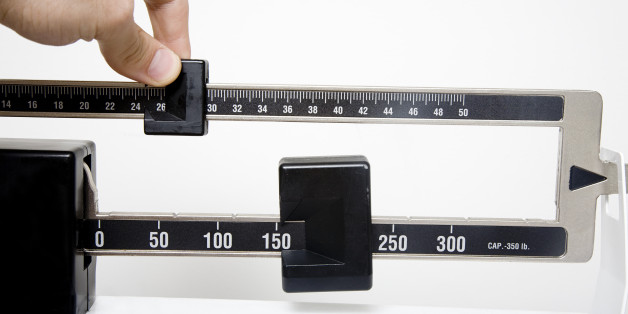Speed of Eating and Fullness: The Waiting Game Solution
While the disappearance of hunger is almost instantaneous after you start eating, the arrival of pleasant fullness takes some time. The less you eat during the time that it takes the stomach to notify your brain that it is full, the less you will overeat. The solution is obvious: slow down.
Pace-Eating: Half-by-5 and All-by-10 Schedules
When we eat, we tend to eat the entire portion. This kind of eating doesn’t factor in the delay between your stomach’s knowing you are full and your brain’s knowing you are full. As a result, we overeat (by eating beyond the point of pleasant fullness). The following are two pace-eating schedules based on the idea that the more you eat in the first sitting, the longer you should wait before you eat again. Half-by-5: divide the portion in half, eat the first half, and take a five minute break. If still not pleasantly full, eat the remainder of the food. All-by-10: eat all that’s in front of you. Wait ten minutes. If still not pleasantly full, have a second helping. For habit-modifying effect, apply the pace-eating schedule of your choice to the largest meal of the day.
Rest Your Hands Technique
Resting your hands between bites will help you slow down the pace of eating to give fullness time to emerge. Lay down the utensils, rest your hands on the table for 10-20 seconds. No need to keep track of time. Just a simple touch-down of your hands on the tablecloth. If you eat alone, or are not afraid of coming across as a bit eccentric, try the following. Get two tiny touch bells and put them on each side of the dish. When you rest your hands, you’ll hear a ring tone as your hands touch the bells. What shall you do during the pause? Take a breath and listen to the sound fade. Wait to eat another bite until the sound of the bell has faded into silence.
Inverted Eating Race
When eating with a like-minded mindful-eating partner, try to outdo each other in how slowly you can finish the meal. Fill in the pauses with talk. The loser pays the bill. Before you start, say in unison: “Instead of leaving room for dessert, let’s leave some room for conversation!”
The Admittedly Annoying Thorough Chewing Exercise
One of the commonly overlooked phases of digestion is chewing. Chewing takes time, and time facilitates fullness. Conscious chewing is a good way to slow down eating to give fullness time to emerge. Some writers recommend chewing for a certain number of reps; but that feels too much like exercise. I suggest you study chewing. What side of the mouth do you chew on? What’s your natural average number of chewing motions per bite? What’s it like to have food in the mouth and not chew, just letting it sit there for a moment. How do you decide when you have chewed enough and it’s time to swallow? Let’s chew on that for a couple of weeks.
Slow Eating Record
Buy a bag of Hershey kisses. Take one out. Dump the rest into the trash can. Now that you have only one Hershey kiss, make this kiss last. Make love to it the way you would to the lips of a parting partner. Kiss it good-bye. Let your tongue slow-dance, gradually unlocking the nuances of the flavor. Of course, you can’t always freeze-frame in this type of gusto-sensual reverie when you eat. But, at least, set the record straight: you can slow-eat when you choose to.
Counting the Chips
How long does an average bag of chips last when you are vegging in front of TV? How long is it before your finger run into the disappointment of broken chip fragments at the bottom of the bag? Try something different: count the chips. First look at the bag of chips and make a prediction. Then count the chips as you eat them. If you are not going to finish the bag, jot down the number on the bag with a marker and continue counting when you come back to this bag of chips during your next “snack attack.” Compare the actual results with your prediction. Even if there were not as many chips as you thought there might be, I am sure that the experience of counting the chips would certainly help you slow down and would help you prevent a sense of disappointment. Apply this counting tactic to other finger-food snacks and sweets. For example, make a guess of how many raisins or almonds you’d find in your particular bag of trail mix. Count them up or risk inhaling countless calories without a sense of fulfillment.
Reminiscence Eating
Eating links people, places and things of our pasts, and as such, can be a great way of going down memory lane, on a journey of self-remembering. Reminiscent eating is an opportunity to turn a simple act of eating into an existentially meaningful experience with the added advantage of slowing down the process of eating (and thus giving fullness time to emerge). Next time you eat, look at the food in front of you and allow yourself to free-associate about the past. What does this dish, this smell, this taste remind you of? Give yourself a taste of the past and turn what could have been mechanical and meaningless into sentimental and mindful.
A Cooling Off Period
Think of the times you burnt your lips on a bowl of soup: isn’t it amazing that we are in such a rush to eat we are willing to burn ourselves?! Next time you have a bowl of soup in front of you give it a few moments to cool off. Stir it, mindfully, watching the vortex of colors swirl. Gently blow air on it, unlocking the aroma. Look around. Enjoy the wait, exhale the impatience, chill.
Pavel Somov, Ph.D, EATING THE MOMENT: 141 Mindful Practices to Overcome Overeating One Meal at a Time (New Harbinger, 2008)
www.eatingthemoment.com
-
Lose Your Weight with Raw Food Diet
If you are eyeing weight loss, raw food diet can help you achieve it.
-
The Facts About “Water Weight” (And The Foods That Cause It)
You’ve started you
-
Don’t Ask Google How To Lose Weight!
I just searched Google “how to lose weight” and was
-
5 Ways To Lose Weight For Summer Without Going On A Crazy Diet
-
Does The HTC Flyer 7 Have The Possibility To Be Very Good Tablet PC?
When apple unveiled the iPad, it single handily designed a specific en
-
Get Moving To Drop a Few Pounds & Enhance Your Confidence
To many people running is what coaches f
- DON'T MISS
- Exercise And Low Carb Diets Make Poor Partners
- The Pros & Cons Of A High Protein Diet
- Heart-Healthy Meal Plans
- 8 Fast Weight Loss Tips- Fast Weight Loss Tips to Strip that Fat
- Fat Loss Workout for Beginners
- No Excuses: How One Woman Lost 75 Pounds While Working 3 Jobs!
- Is HGH Related to fat loss? Know how
- Eating Strategies To Lose Five Pounds Of Body Fat
- Stand Up For Health and Weight Loss
- Are You Really Hungry




